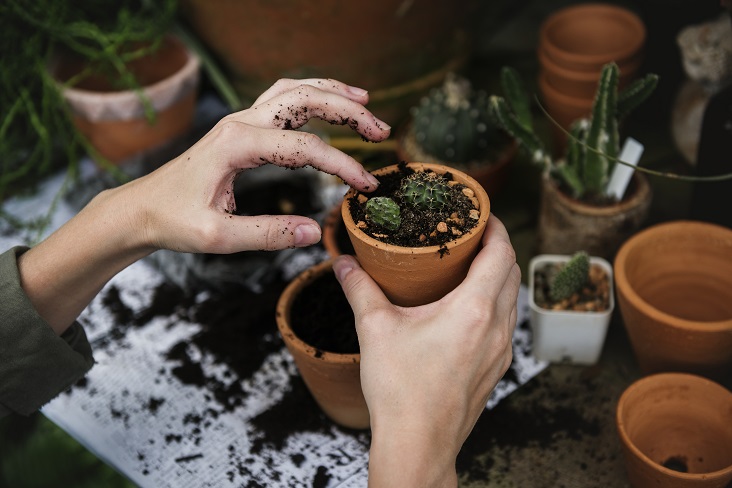The jungle you live in is an urban one, sadly bereft of greenery. You would buy a plant or two, to boost your sense of well-being as well as prove to yourself and your mother that you meet the threshold of “responsible adult.” Sadly, one of your windows only lets in a sliver of light; the other faces a brick wall. What’s a flora-phile to do?
You make your way to your local plant store or nursery anyway, keeping in mind that certain plants that can survive—and even thrive—in low light, giving your space some much-needed life and sweet, sweet oxygen.
Here’s a look at some foliage to brighten even the darkest apartments.
Dallas Fern
An offshoot of the Boston Fern, the Dallas variety better tolerates fewer lumens. Its fronds only grow half the length of the Boston version, so it doesn’t have the lovely cascade effect of its primogeniture. However, its compact nature keeps it from splaying across the rest of your precious counter space.
As green designer Pablo Solomon says, “Since ferns out survived the dinosaurs, they must have something going for them.” That means they may even survive you.
Mosses
Solomon recommends green mosses, of which there are 12,000 species, most of which grow in shade. But nature’s carpet doesn’t need to stay at floor level. He says, “These require little light, very little care other than being kept moist and can be coaxed to grow on interesting rocks, sculptures, [and] pieces of driftwood.”
As long as your moss has moisture, it’s easy to grow. It’s also easy to acquire: You can buy all sorts of varieties in your local plant store…and on Etsy.
Snake Plant/Mother-in-Law’s Tongue/Sansevieria trifasciata
Charlie D. La Marr, a former interior architect, and designer who specialized in environmental design and sick-building syndrome, consider mother-in-law’s tongue a go-to plant for all interiors, even low light ones. “You can’t kill them,” she says. Also, “they are one of the hardest-working plants on earth when it comes to transforming bad air into clean air.”
Don’t just take La Marr’s word for it. Take NASA’s. This plant was given a thumbs-up in its Clean Air Study.
Parlour Palm/Neanthe Bella Palm/Chamaedorea Elegans
Anthony Smith, the owner of Nursery Enterprises, says the parlor palm requires low light. It also can tolerate “low humidity, bad air, near-freezing temperatures, and some neglect.” In other words, it’s perfect for a busy apartment dweller (Or even a college dorm).
Its ability to tolerate the vagaries of human caretaking, plus its simple fanning fronds, make the parlor palm one of the world’s most popular indoor plants. It’s also a plant that won’t break your budget. That’s what orchids and Juliet roses are for.
Cast Iron Plant/Bar Room Plant/Aspidistra elatior
Smith says the cast-iron plant “can grow in shade and cannot tolerate direct sun. They are very tolerant of indoor polluted air and general neglect and can survive down to freezing.”
The bushy, wide-leafed aspidistra may appeal to lovers of history and literature: It was popular in London during the smoggy, foggy Victorian era because of its ability to filter pollutants from the air. It later became memorialized as a symbol of the middle class in the pre-1984 George Orwell novel Keep the Aspidistra Flying.
Heartleaf Philodendron/Sweetheart Plant/Philodendron scandens
Another entry in the NASA clean air study, the heartleaf philodendron, in fact, has pretty, heart-shaped leaves with an eye-catching high gloss. Smith says, “You can train [the philodendron] to climb or to remain short and wide or to drape downward…. It can also survive down to around 38 degrees F.”
Although this plant prefers dappled sunlight, it grows fine—albeit less vibrantly—in low light. In fact, Smith cautions against exposing this plant to full sunlight. In other words, it’s a perfect hangover buddy.
Notes:
– Other suggestions from botanists and nursery owners include peace lilies, many ivies (devils ivy, Pothos ivy, English ivy, Algerian ivy) spider plant, philodendron, the ZZ plant, Chinese evergreen, and certain ficuses (rubber plant, fiddle leaf fig).
– Apartment too dark even for a houseplant? Michael Bolos, plant fan and co-founder of DeskView has used metal halide, fluorescent, and LED lighting to help his indoor gardens grow.
– Whip out your smartphone’s compass and see what direction your windows face. Bolos says that southern exposure gives you a broader range of options when it comes to plants. Plants at an Eastern and Western exposure will grow, but may “grow leggy.” Northern exposure, sadly, limits your choices of foliage.
– Light is only one piece of the puzzle that is caring for a houseplant. Keep in mind that all plants need different temperatures and watering schedules, not to mention humidity. (Bolos suggests you buy yourself a humidifier.) Some may be poisonous to house pets too, so ask your plant seller if it’s okay to bring your new plant home to Whiskers or Fido.
– If your apartment is blessed with a little outdoor space, check out some outdoor plant options that naturally repel the planets most annoying insect — the mosquito.
Thanks to Jill Rodriguez of Red Leaf Garden, Stan Miklis of Caliper Farm to Market, and Gena Lorainne of Fantastic Services.

